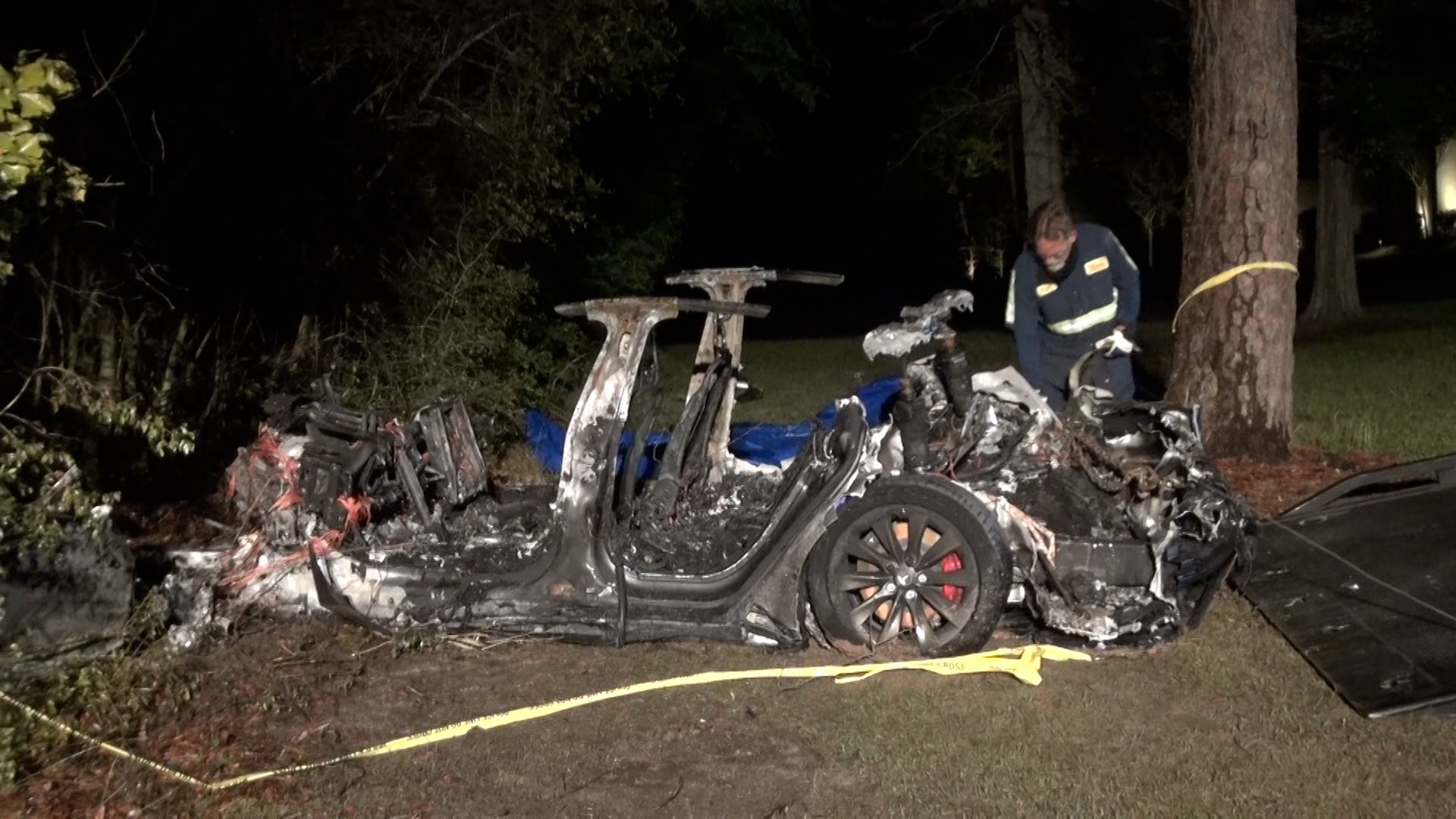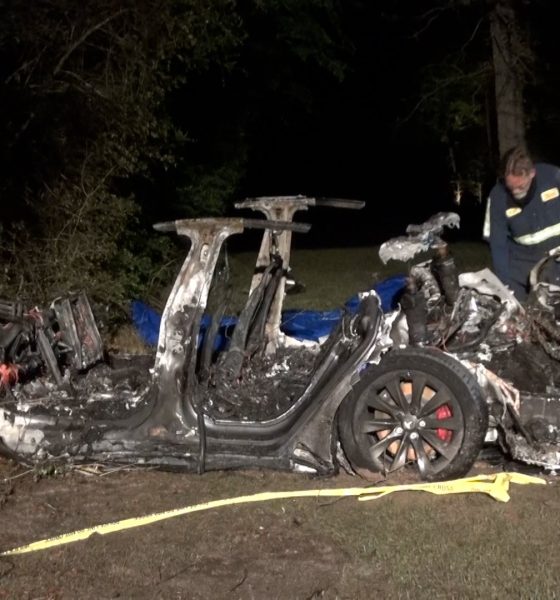

News
Elon Musk roasts WSJ coverage of fatal Tesla crash, defends Autopilot
Tesla CEO Elon Musk roasted the Wall Street Journal for their coverage of the crash that killed two men involving a 2019 Model S. Mainstream media reports claimed that the vehicle was “driverless” in an attempt to cast bad press on Tesla’s Autopilot and Full Self-Driving systems. Musk shared new details regarding the vehicle involved, revealing that the car was not subscribed to the Full Self-Driving program, a voluntary purchase made by Tesla owners, nor could it have been operating on Autopilot due to a lack of road lines.
Musk, in a reply to a skeptical Twitter user who didn’t believe a media outlet’s coverage of the accident, said:
“Data logs recovered so far show Autopilot was not enabled & this car did not purchase FSD. Moreover, standard Autopilot would require lane lines to turn on, which this street did not have.”
Tesla alleged “driverless” crash in Texas: What is known so far
The Wall Street Journal reported the story with the headline “Fatal Tesla Crash in Texas Believed to Be Driverless.” This uses the automatic association that Tesla electric vehicles have with self-driving programs. However, Tesla does not, nor has it ever claimed to have a self-driving vehicle or software that would make a car drive without the driver needing to pay attention. Tesla has a suite called Full Self-Driving (FSD) but has maintained that it is still the driver’s responsibility to pay attention to the road and abide by all road rules. The FSD suite is available for $10,000 and can be purchased at any time.
Your research as a private individual is better than professionals @WSJ!
Data logs recovered so far show Autopilot was not enabled & this car did not purchase FSD.
Moreover, standard Autopilot would require lane lines to turn on, which this street did not have.
— Elon Musk (@elonmusk) April 19, 2021
However, the vehicle involved in the accident was not subscribed to the FSD program. Tesla keeps records of its cars and can track whether any car has FSD or not. Musk claims that data logs that have been recovered thus far show that the involved vehicle did not have FSD.
Additionally, Tesla’s basic Autopilot suite, which now comes standard on every vehicle, would not have been able to function with the road conditions presented in the area of the accident. Standard Autopilot requires road lines to be functional. This road was unmarked, so Tesla’s basic Autopilot feature would not have been active. It’s impossible.
Unfortunately, Tesla’s Autopilot and Full Self-Driving suites are usually the first points of blame when an accident occurs. When Tesla’s are involved in violent or fatal accidents, they are very publicly covered by media outlets. It only adds fuel to the skeptic’s fire against the FSD and self-driving programs that Tesla is currently working on completing. In the past, Elon Musk has stated that Tesla may accomplish Level 5 autonomy by the end of 2021, but the CEO and the company have never claimed that a Tesla vehicle can drive itself. The company has also enforced several barriers that would prevent a driver from letting the vehicle operate independently. If a driver does not keep their hands on the steering wheel while the car is in motion, the vehicle will automatically pull over, and Autopilot will be deactivated for the remainder of the drive.
The company also has revoked FSD access to some drivers after abusing the capabilities of the software and not handling it responsibly.
This should dismiss the idea that AP was somehow the cause of this horrific incident. I pray for the family and friends of the deceased. Let’s trust the real investigators will discover what really happened here. pic.twitter.com/0tp8Vbh6fH
— Mikey Likes (@mliebow) April 18, 2021
Reports indicate that the NHTSA has launched an investigation into the Texas crash to determine the cause of the fatal collision.
Tesla recently released its Q1 2021 Safety Report, which showed that cars operating on Autopilot are nearly ten times safer than cars that are being operated by a humans.

News
Tesla aims to combat common Full Self-Driving problem with new patent
Tesla writes in the patent that its autonomous and semi-autonomous vehicles are heavily reliant on camera systems to navigate and interact with their environment.

Tesla is aiming to combat a common Full Self-Driving problem with a new patent.
One issue with Tesla’s vision-based approach is that sunlight glare can become a troublesome element of everyday travel. Full Self-Driving is certainly an amazing technology, but there are still things Tesla is aiming to figure out with its development.
Unfortunately, it is extremely difficult to get around this issue, and even humans need ways to combat it when they’re driving, as we commonly use sunglasses or sun visors to give us better visibility.
Cameras obviously do not have these ways to fight sunglare, but a new patent Tesla recently had published aims to fight this through a “glare shield.”
Tesla writes in the patent that its autonomous and semi-autonomous vehicles are heavily reliant on camera systems to navigate and interact with their environment.

The ability to see surroundings is crucial for accurate performance, and glare is one element of interference that has yet to be confronted.
Tesla described the patent, which will utilize “a textured surface composed of an array of micro-cones, or cone-shaped formations, which serve to scatter incident light in various directions, thereby reducing glare and improving camera vision.”

The patent was first spotted by Not a Tesla App.
The design of the micro-cones is the first element of the puzzle to fight the excess glare. The patent says they are “optimized in size, angle, and orientation to minimize Total Hemispherical Reflectance (THR) and reflection penalty, enhancing the camera’s ability to accurately interpret visual data.”
Additionally, there is an electromechanical system for dynamic orientation adjustment, which will allow the micro-cones to move based on the angle of external light sources.
This is not the only thing Tesla is mulling to resolve issues with sunlight glare, as it has also worked on two other ways to combat the problem. One thing the company has discussed is a direct photon count.
CEO Elon Musk said during the Q2 Earnings Call:
“We use an approach which is direct photon count. When you see a processed image, so the image that goes from the sort of photon counter — the silicon photon counter — that then goes through a digital signal processor or image signal processor, that’s normally what happens. And then the image that you see looks all washed out, because if you point the camera at the sun, the post-processing of the photon counting washes things out.”
Future Hardware iterations, like Hardware 5 and Hardware 6, could also integrate better solutions for the sunglare issue, such as neutral density filters or heated lenses, aiming to solve glare more effectively.
Elon Musk
Delaware Supreme Court reinstates Elon Musk’s 2018 Tesla CEO pay package
The unanimous decision criticized the prior total rescission as “improper and inequitable,” arguing that it left Musk uncompensated for six years of transformative leadership at Tesla.

The Delaware Supreme Court has overturned a lower court ruling, reinstating Elon Musk’s 2018 compensation package originally valued at $56 billion but now worth approximately $139 billion due to Tesla’s soaring stock price.
The unanimous decision criticized the prior total rescission as “improper and inequitable,” arguing that it left Musk uncompensated for six years of transformative leadership at Tesla. Musk quickly celebrated the outcome on X, stating that he felt “vindicated.” He also shared his gratitude to TSLA shareholders.
Delaware Supreme Court makes a decision
In a 49-page ruling Friday, the Delaware Supreme Court reversed Chancellor Kathaleen McCormick’s 2024 decision that voided the 2018 package over alleged board conflicts and inadequate shareholder disclosures. The high court acknowledged varying views on liability but agreed rescission was excessive, stating it “leaves Musk uncompensated for his time and efforts over a period of six years.”
The 2018 plan granted Musk options on about 304 million shares upon hitting aggressive milestones, all of which were achieved ahead of time. Shareholders overwhelmingly approved it initially in 2018 and ratified it once again in 2024 after the Delaware lower court struck it down. The case against Musk’s 2018 pay package was filed by plaintiff Richard Tornetta, who held just nine shares when the compensation plan was approved.
A hard-fought victory
As noted in a Reuters report, Tesla’s win avoids a potential $26 billion earnings hit from replacing the award at current prices. Tesla, now Texas-incorporated, had hedged with interim plans, including a November 2025 shareholder-approved package potentially worth $878 billion tied to Robotaxi and Optimus goals and other extremely aggressive operational milestones.
The saga surrounding Elon Musk’s 2018 pay package ultimately damaged Delaware’s corporate appeal, prompting a number of high-profile firms, such as Dropbox, Roblox, Trade Desk, and Coinbase, to follow Tesla’s exodus out of the state. What added more fuel to the issue was the fact that Tornetta’s legal team, following the lower court’s 2024 decision, demanded a fee request of more than $5.1 billion worth of TSLA stock, which was equal to an hourly rate of over $200,000.
Delaware Supreme Court Elon Musk 2018 Pay Package by Simon Alvarez
News
Tesla Cybercab tests are going on overdrive with production-ready units
Tesla is ramping its real-world tests of the Cybercab, with multiple sightings of the vehicle being reported across social media this week.

Tesla is ramping its real-world tests of the Cybercab, with multiple sightings of the autonomous two-seater being reported across social media this week. Based on videos of the vehicle that have been shared online, it appears that Cybercab tests are underway across multiple states.
Recent Cybercab sightings
Reports of Cybercab tests have ramped this week, with a vehicle that looked like a production-ready prototype being spotted at Apple’s Visitor Center in California. The vehicle in this sighting was interesting as it was equipped with a steering wheel. The vehicle also featured some changes to the design of its brake lights.
The Cybercab was also filmed testing at the Fremont factory’s test track, which also seemed to involve a vehicle that looked production-ready. This also seemed to be the case for a Cybercab that was spotted in Austin, Texas, which happened to be undergoing real-world tests. Overall, these sightings suggest that Cybercab testing is fully underway, and the vehicle is really moving towards production.
Production design all but finalized?
Recently, a near-production-ready Cybercab was showcased at Tesla’s Santana Row showroom in San Jose. The vehicle was equipped with frameless windows, dual windshield wipers, powered butterfly door struts, an extended front splitter, an updated lightbar, new wheel covers, and a license plate bracket. Interior updates include redesigned dash/door panels, refined seats with center cupholders, updated carpet, and what appeared to be improved legroom.
There seems to be a pretty good chance that the Cybercab’s design has been all but finalized, at least considering Elon Musk’s comments at the 2025 Annual Shareholder Meeting. During the event, Musk confirmed that the vehicle will enter production around April 2026, and its production targets will be quite ambitious.








